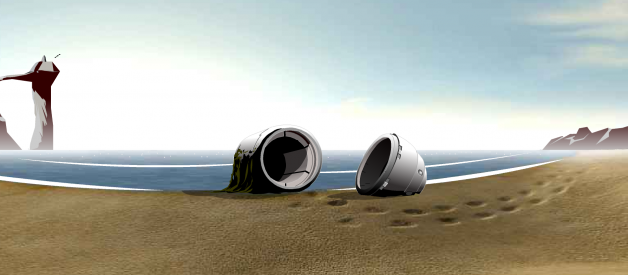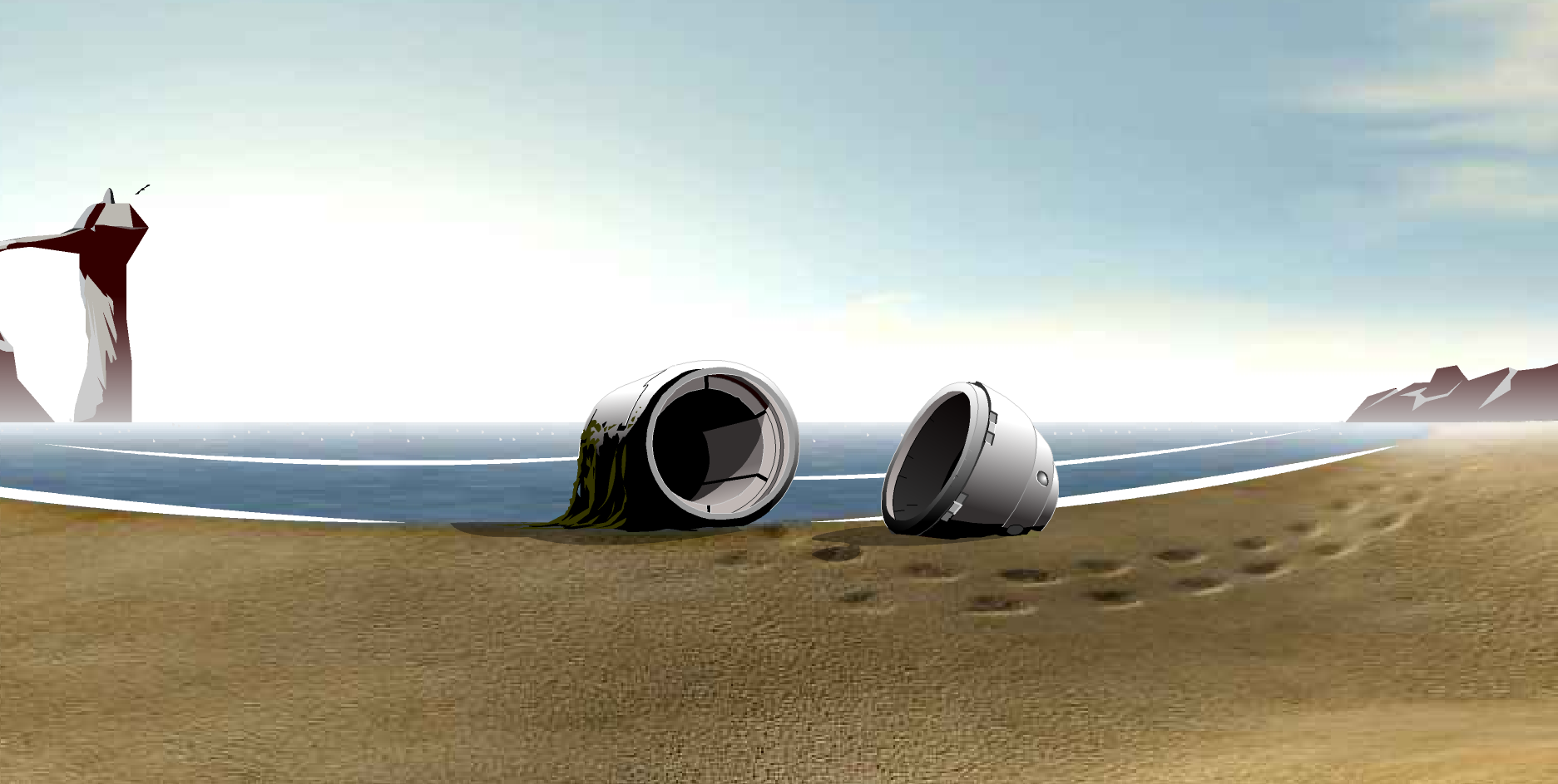
This story was published concurrently in video form by Subpixel.
Gathered friends,
Listen again to our legend, of the Bionicle?
Devoted fans of The LEGO Group are likely familiar with their Bionicle product line, the first of LEGO?s first-party, story-driven intellectual properties, and one that, without which The LEGO Group may not even exist today. Now, I say ?likely familiar? only to be polite, because you?d literally have to have lived under a rock or been born sometime since 2010 to have any excuse not to know about Bionicle in even the smallest way. And even at that, the line got rebooted in 2015 for a second generation, so if all this is totally unfamiliar to you, let?s sit down some time ? I?ll get you up to speed.
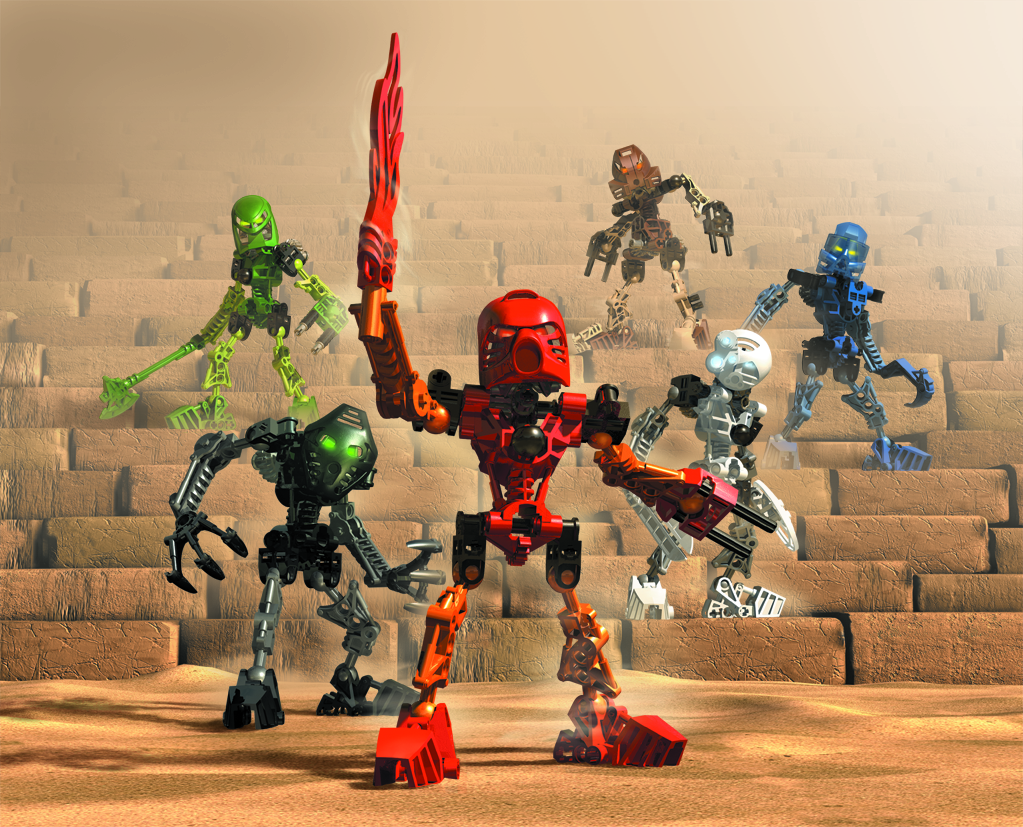 Key art for Bionicle
Key art for Bionicle
Bionicle was The LEGO Group?s response, in part, to the Pokemon series ? which, according to LEGO?s internal reports from 1998 and 1999, had made a sizable dent in LEGO?s market share of worldwide toy sales. Having cut 1,500 jobs during ?98 and ?99 and still dancing on the edge of bankruptcy in early 2000, Bionicle was lighting in a bottle for The LEGO Group. Its success was so vast and so immediate that for all intents and purposes it single-handedly brought the company back from the brink of financial collapse. LEGO Star Wars and LEGO Harry Potter certainly played their part, but the effect of Bionicle?s success on The LEGO Group?s current standing as an international toymaker cannot be overstated.
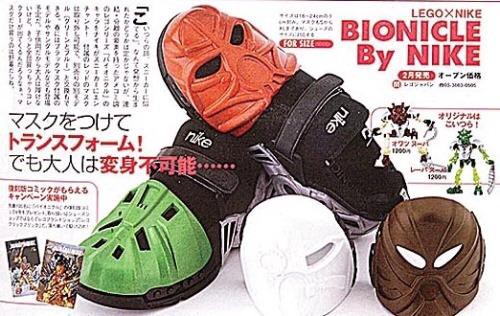 Print advertisement for Nike?s Bionicle shoes
Print advertisement for Nike?s Bionicle shoes
The success of the product line was due not only to the novelty and design of the toys themselves ? being part of what would soon be called ?constraction? toys ? a new taxonomy to distinguish LEGO?s constructable action figures (hence ?constr-action?) from more traditional forms like GI Joe; but also because of the strong multimedia tie-ins The LEGO Group released in conjunction with the physical toys. This involved comics, books, movies, shoes, and videogames ? the latter of which involved a now somewhat infamously cancelled PC game called LEGO Bionicle: The Legend of Mata Nui; and due to Legend?s cancellation, the now even more famous Mata Nui Online Game ? a Flash-based browser game from New York based developers Templar Games Inc ? known then as Templar Studios. And it is this masterpiece of Flash gaming that we?ll be talking about today.
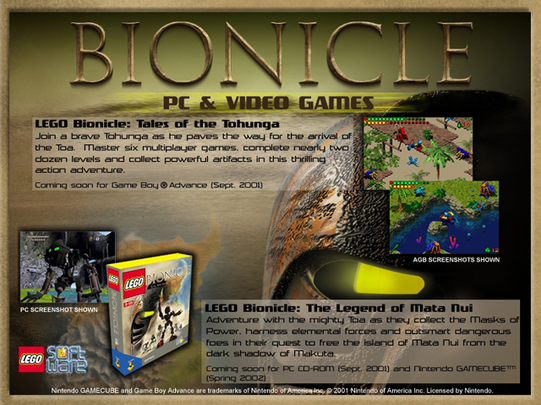 Print advertisement for the cancelled LEGO Bionicle: Legends of Mata Nui
Print advertisement for the cancelled LEGO Bionicle: Legends of Mata Nui
My first experience with Mata Nui Online Game was at age nine on a computer in a local library ? because the computers at the library had better internet speeds than we had at home ? and it was a transcendent experience. It was by no means the first videogame I?d ever played, but it was the first time I realized that games could be art. Sure, I didn?t think of it in those terms as a nine year old, but in looking back on those memories of Mata Nui I know that was the moment when games became something more to me.
Now here in 2020, as Flash grows closer and closer to the end of its very long life, I decided to hit the web and see what I could dig up on my favorite Flash game of all time. Making these videos for Subpixel has sent me down some pretty interesting internet rabbit holes the past few years, and this was no different. I first discovered that Templar Games have a number of Mata Nui Online Game postmortem developer diaries up on their tumblr account, which are immensely fascinating to sift through if you get a chance. But I wanted more. And Templar?s general inquiry address seemed like a good place to start.
I was met with a response from none other than the President of Templar Games, Peter Mack, who provided me with some remarkable insight into the development of the Mata Nui Online Game. So here is, from the developers themselves, an oral history of Mata Nui Online Game.
Our story begins not with Mata Nui Online Game itself, but with a different game Templar developed for The LEGO Group for their Mindstorms product line ? a game called Stormrunner. Also developed in Flash, Stormrunner was Templar?s ticket into, as Mack put it in our email exchange, the ?ultra-secret product and story development process? for Bionicle. In late 1999, as development for Stormrunner drew near its end, LEGO approached Templar to develop something for the new line ? though at that point it wasn?t certain if that would be a game, a website, or something else entirely. As I mentioned earlier, Bionicle as a toy and as an intellectual property was entirely new territory for The LEGO Company, so much of the marketing was still uncertain in the early days of the project.
It was during this period that Mack recalled trips to Coppenhagen and Billund for initial sales meetings, at which time he was introduced to a variety of marketing materials already assembled by The LEGO Group and its various third party contractors. Among these materials was a vast story Bible ? which was still being revised at the time, according to Mack ? and a design document that had been assembled by Danish creative agency ADVANCE, which included 3D key art that would eventually go on to be used on the packaging for Bionicle?s many sets, and concept art for the island of Mata Nui and a handful of the island?s locales.
These meetings continued back on the other side of the Atlantic with a meeting at the Grand Hyatt in New York City on July 7, 2000. Then in August ? a year before Bionicle?s physical sets would appear on North American store shelves ? Templar presented to LEGO their idea for, in Mack?s words, ?a Myst-style adventure? set on the island of Mata Nui. And finally, in a Letter of Intent from The LEGO Group ? dated September 14, 2000 ? Templar, working from an exhaustive story bible assembled in various parts by former LEGO Head of Character and Story Development Bob Thompson and BAFTA nominated writer Alastair Swinnerton ? who was working then with a team of writers at Skryptonite (a UK based script services company) ? Templar set about creating the world of Mata Nui.
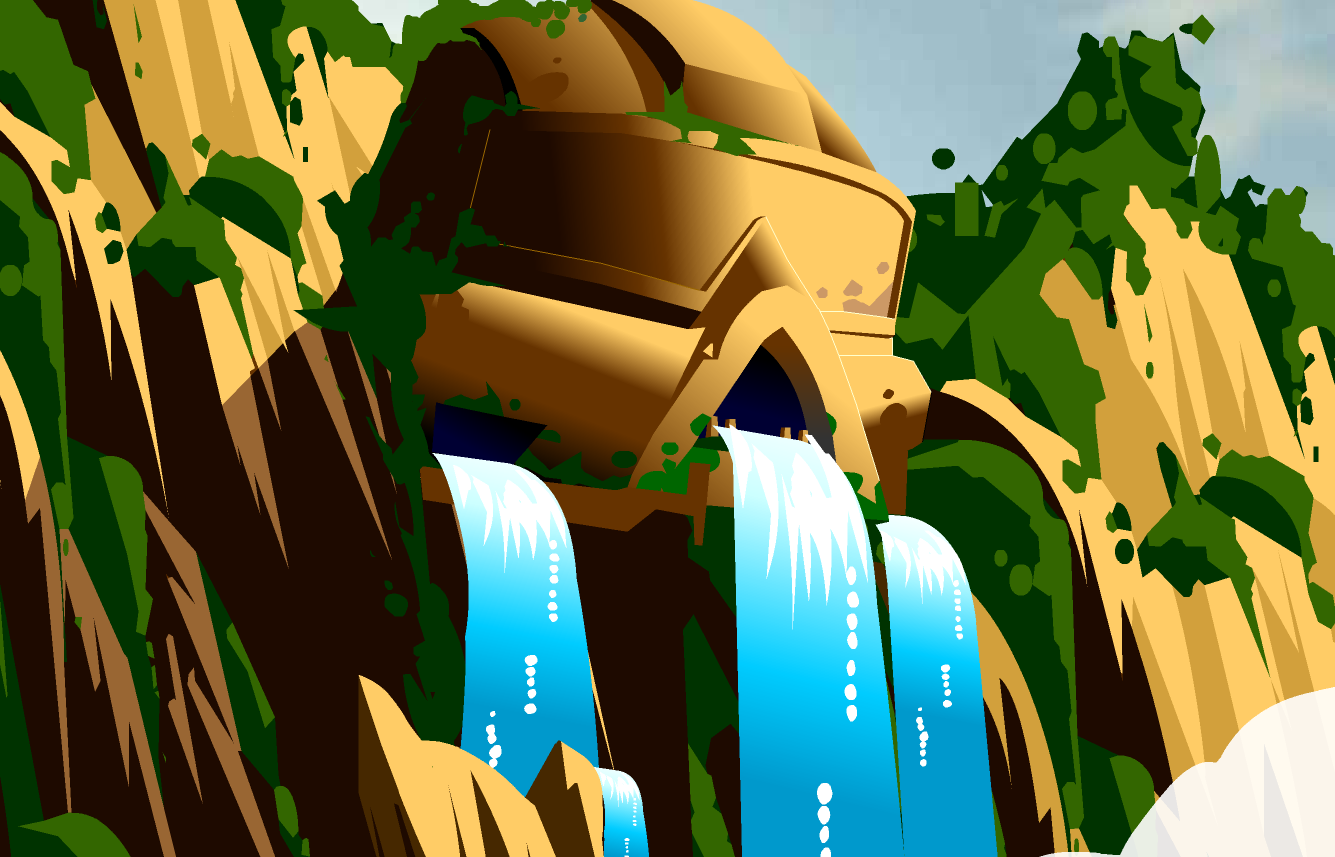 A waterfall overlooking the floating city of Ga-Koro
A waterfall overlooking the floating city of Ga-Koro
But if it has not yet become obvious, Mata Nui Online Game was not originally developed with the knowledge that it would essentially become the de facto storyline for Bionicle in 2001. In fact, the team at Templar often felt like they were an afterthought amidst the greater Bionicle marketing push. Mack said that Templar?s mission at the time was to ?communicate the world of Mata Nui,? though he assumed LEGO would have likely accepted ? in his words ? ?a trivia game, or a nicely illustrated wiki.? The broad strokes of the Bionicle storyline had already been planned out ? going as far as seven years into the future of the canon, but it was the day to day goings-on of the island that were still uncertain. And it was that uncertainty that Templar intended to clarify.
Though for whatever vague assignments the team at Templar had been given, the broad strokes nature of the Bionicle story Bible showed that the primary adventures of the Toa had already been definitively planned out for other media, and as such were off limits to the team at Templar. They would need to tell a story with the leftovers, with characters Mack called ?misfits and comic relief characters that were, at best, footnotes in the style guide.?
And not only were the few characters Templar had at their disposal secondary to the primary events of the greater Bionicle saga, they weren?t even part of the main toy line, but promotional figures that came with McDonald?s Happy Meals.
But even with these restrictions, former LEGO Group Creative Director Russell Stoll was convinced that Templar could make something great, and pushed for Mata Nui Online Game to have a greater role in the storytelling of Bionicle?s early narrative. Stoll was in charge of online community development for LEGO.com in the late 90s and early 2000s, and according to Templar?s tumblr diaries, had convinced LEGO to let Mata Nui Online essentially launch the story of Bionicle and then let the aforementioned PC game, movie, and comics pick up the narrative down the line.
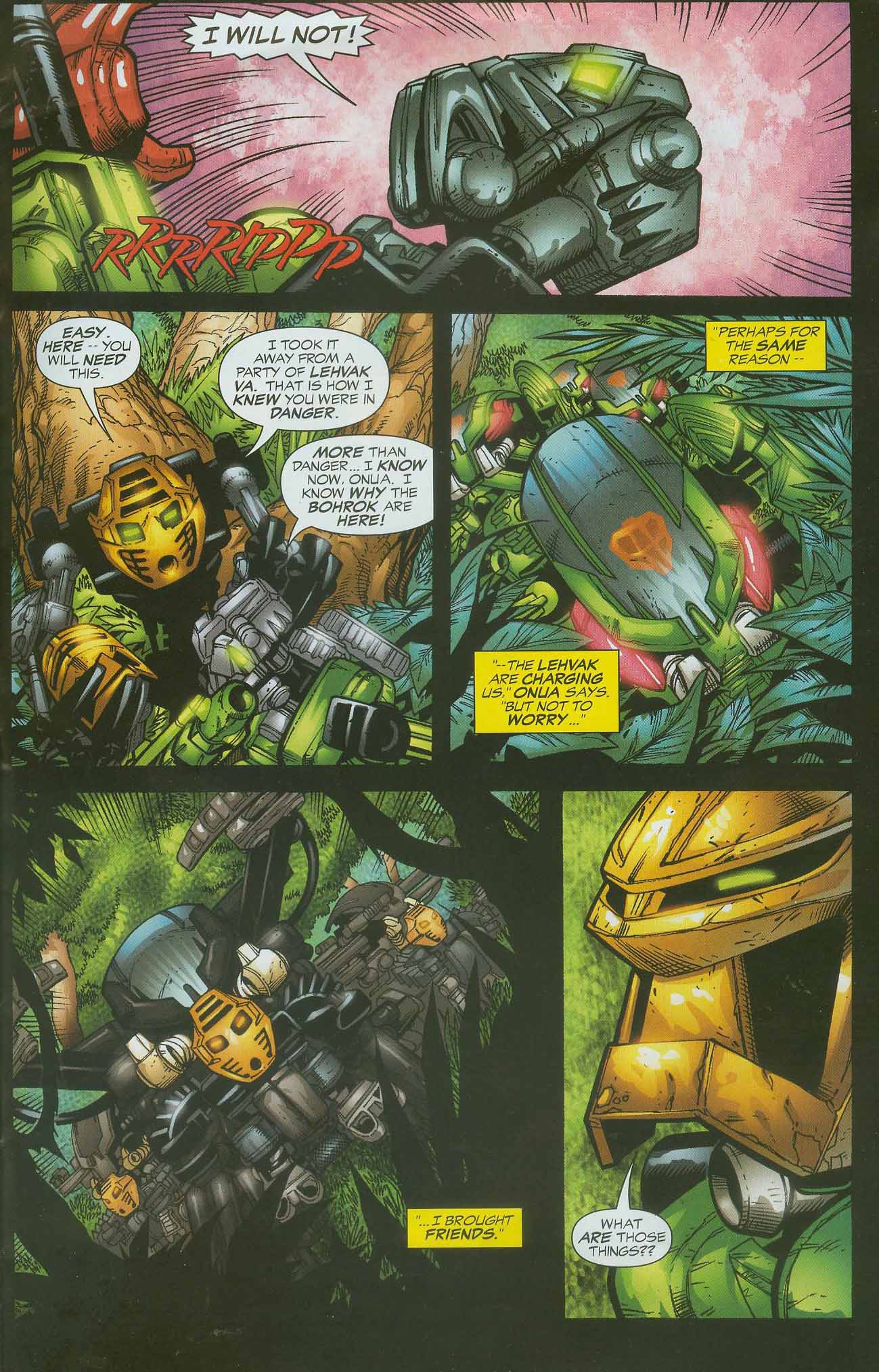 A page from DC & LEGO?s Bionicle comics
A page from DC & LEGO?s Bionicle comics
Mack recalled a strategy document dated in 2000 that laid out LEGO?s plans for storytelling in the Bionicle universe. Six boxes representing the six chapters of The Legend of Mata Nui PC game ? and each of the Toa?s primary adventures on the island ? served as the backbone for a chart breaking down the story, with these boxes encased in dotted lines that represented the Bionicle website with it?s additional storytelling from Templar ? as yet still undefined in the greater canon. But it?s the absence of something in the strategy document that is most interesting within our tale. According to Mack, the Bionicle comics are conspicuously absent from this 2000 strategy document. The lack of emphasis on the comics and abundance of emphasis on the PC title shows that, at least in 2000, LEGO had every intention of letting The Legend of Mata Nui do the brunt of Bionicle?s narrative development once the line really kicked off. Mata Nui Online Game would still just be the prelude ? at least for now.
But the aforementioned and now infamous cancellation of The Legend of Mata Nui would change all that. I couldn?t track down much by way of LEGO?s official stance on the matter beyond communication between Bionicle fansite MaskofDestiny.com and a LEGO spokesperson that ? in a post from Mask of Destiny user Purple_Dave ? is only mentioned as ?Michael?. The post claims that, amongst other things, LEGO was concerned about chip compatibility and the timing of the game?s release, and as such pulled the plug.
Now there are other potentially move relevant details we could get into here, Legend of Mata Nui developer Saffire Inc.?s at the time unstable financial situation chief among them, but all that is tangential to the one point we really need to know for the sake of Mata Nui Online Game: Legend of Mata Nui was cancelled, and though the cancellation occured definitively in October of 2001, well after the first of Templar?s Mata Nui Online programs went up on Bionicle.com, its cancellation presented a unique opportunity for Templar to end their own game with greater narrative impact than previously thought. Mack recalled that he and the team at Templar were shocked by the news of Legend?s cancellation, but now we?re getting ahead of ourselves.
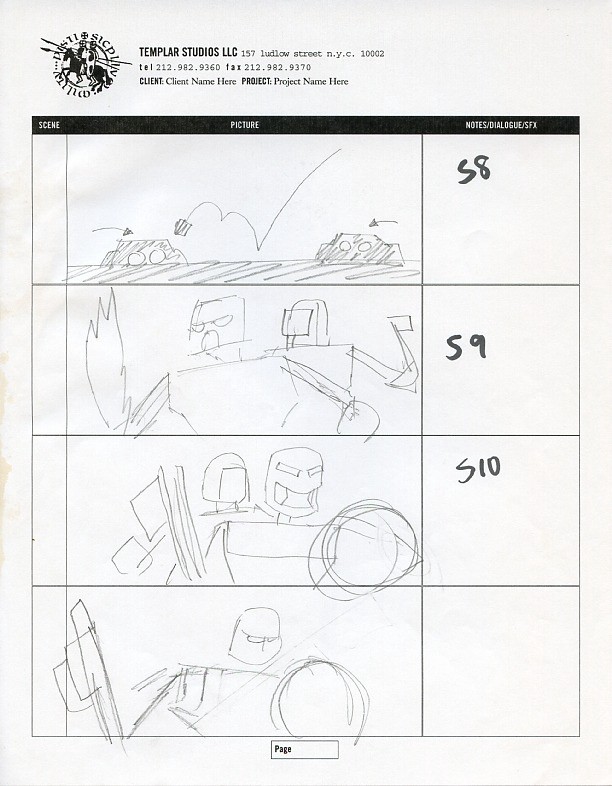 Storyboards for MNOG?s animated cutscenes
Storyboards for MNOG?s animated cutscenes
Let?s rewind back to pre-production for Mata Nui Online Game. In developing the world of Mata Nui, Templar found more problems beyond just the lack of fully-fleshed characters at their disposal. The Bionicle brand posed other narrative issues for the team at Templar ? but unlike the issue of characters, these weren?t problems inherent to the Bionicle IP itself, but problems more related to how the property fit within The LEGO Group?s company philosophies. For decades LEGO had striven to be a company about creativity and play, not violence. Even the name ?LEGO? is derived from the Danish words for ?Play well?. So what was LEGO to do with Bionicle, where the main characters had sharp axes, flaming swords, and piercing hooks and claws? And how was Templar to tell a story of good vs. evil without the use of violence?
Mack recalled two competing camps within The LEGO Group. The product team, the ones actually designing the physical sets, obviously had no problem with violence ? or at the very least, the idea of it, when they gave their heroes swords, axes, and other dangerous implements; but the hesitance at the Bionicle heroes? aggressive appearance came from the marketing team, who were hoping to hold on to LEGO?s as-yet-untarnished identity as an educational, non-violent, family brand.
Eventually word came from the marketing team in Denmark ? a compromise of sorts: the Toa did not have weapons, they have tools. But this too presented new problems for the team at Templar, namely: combat within the game?s animated cutscenes. Mack put it this way:
?It was not that easy from a story standpoint, and art-wise it called for more elaborate demises than simply lopping someone in half with an axe.
?Nonetheless, we got it ? our action sequences were full of daring escapes; cave-ins; collapsing bridges, or just-dodged boulders. When someone needed to blast a Rahi, they blasted instead the rocks in the cave above their head. No Rahi were outright stabbed in the making of this game. Buried alive, maybe. And if a ?tool? did find its mark ? it did so off-screen.?
Now, while we?re talking about Mata Nui?s cutscenes, this is probably a good time to talk about Mata Nui Online Game on an aesthetic level. Typically the phrase ?Flash game? doesn?t bring to mind any sort of overly artistic endeavor ? but I hope to change that conception with this video.
Mata Nui Online Game was boundary pushing when it came out. In my emails with Mack I asked if Mata Nui?s stylized, almost Miyazaki-esque art style was a deliberate decision or one that had been necessitated by the limits Flash had at the time. Mack said it was a little bit of both. Gordon Klimes, Templar Games Creative Director and Assistant Director on Mata Nui Online Game, spearheaded this artistic push. According to Mack, Klimes was responsible for setting the artistic tone for Mata Nui Online Game. But again, we?re getting a little bit ahead of ourselves. The roots of Mata Nui?s artistic stylings can be seen in the short Flash cutscenes Templar had made for Stormrunner. Mack said these animations were ?built in Java with an HTML shell?, which is beyond the scope of my limited game development knowledge but I wanted to at least include the specifics here for those of you who may enjoy that kind of minutia.
So, with Stormrunner in the books it was time to move on to Bionicle, and whatever form its website might take. Though LEGO toyed with the idea of just hosting still images on the site, it was decided that animation would have some sort of presence. Knowing that LEGO had been satisfied with the quality of Flash animation Templar had been able to achieve with Stormrunner, Mack and company set about developing the look and style of what would become Mata Nui Online Game?s animated cutscenes.
However, there was some skepticism from higher up the chain of command that Templar could get Flash to really do the Mata Nui animations justice. Now, Mack confided that at least for the first couple programs, the skeptics at LEGO may have been right, but as the team got more comfortable with the software and their own processes they were able to deliver scenes that, in their minds (and the minds of fans playing the game) looked pretty good ? especially for something delivered over a modem.
Rewatching all those cutscenes in preparation for writing this script ? I found myself stunned not only by the art, but also the economy of animation. Templar, given the lemons they had to work with, really made lemonade. For example, in a fight between Lewa and Onua, the battle is hidden in darkness and represented with weapon streaks ? a simple and elegant way to not only show the ferocity of the battle, but also get around the aforementioned moratorium on direct weapon-on-person contact that had been mandated by The LEGO Group. And in Kopaka?s fight with the Muaka, Templar cleverly decided to let Kopaka use Vakama?s mask of invisibility ? which allowed the animators at Templar to not only completely remove Kopaka?s model from the scene, but show direct weapon-on-Rahi combat without actually showing direct weapon-on-Rahi combat. It?s genius.
 A hidden valley of carved statues
A hidden valley of carved statues
But even apart from the animated portions of Mata Nui Online, you could pick any single frame of this game and put it up in any art museum in the country. I know I already mentioned Miyazaki, but it?s a good comparison. Like any of Miyazaki?s films, each frame of Mata Nui Online?s point-and-click locations is painterly and picturesque in its presentation ? drawing the player not only further into the island but further into the little details of each image. Every location begs for you to sit still and observe the world before you ? and I think it was this beauty that helped the game to stay fresh in the weeks between each chapter?s release. The sound design too brings the world of Mata Nui Online to life in ways that contemporary Flash games just didn?t do. The wind through a canyon, the soft lapping of waves on the shore, all but completely immerse you in Templar?s vision of Mata Nui.
And alongside these awe inspiring visuals was an incredible score from Justin Luchter ? a score that remains one of the most enduring pieces of Bionicle media even though Templar?s pitch for a physical CD release of the soundtrack fell on deaf ears. Much as the imagery of Templar?s vision of Mata Nui evokes a certain sense of awe and wonder, and so does the score ? particularly one track that serves more or less as the main theme of Mata Nui Online, a track simply called ?Beach Chant?, where deep voices seem to resonate up from the earth itself in legato style. But even the other, less iconic music from the game still builds on the visible world of Mata Nui in an organic and equally evocative way.
So with these pieces in place, on January 1st, 2001, the first program of Templar?s Mata Nui Online Game was released onto Bionicle.com. Though the first wave of physical sets had already been released in Europe the month before, the Toa weren?t set to land on the shores of the Americas until August of 2001, meaning Mata Nui Online Game would have to hold American fans? attention for the next eight months. The PC game ? at least for now ? was due out in September of 2001, ten months after Mata Nui Online launched and two months after fans would finally have access to the physical sets. The first of the comics wouldn?t be published until June of 2001, and the first book wouldn?t hit store shelves until 2003. Mata Nui Online Game was it.
The first chapter of Mata Nui Online was simple ? a beach, a canister, a telescope, and some rocks. But that first image, of an open canister washed up on the shore, was so stunning, so captivating, that it has since become one of the most ? if not the most ? iconic image in the whole franchise. Unlike almost everything else in Mata Nui Online Game, this image was one of a handful that had already been developed by LEGO and ADVANCE, with the iterations of the canister appearing in various pieces concept art from former ADVANCE Art and Creative Director Christian Faber ? as part of the design document that had been supplied to Templar months earlier. But the way Templar implemented Tahu?s canister into Mata Nui Online is nothing short of perfect.
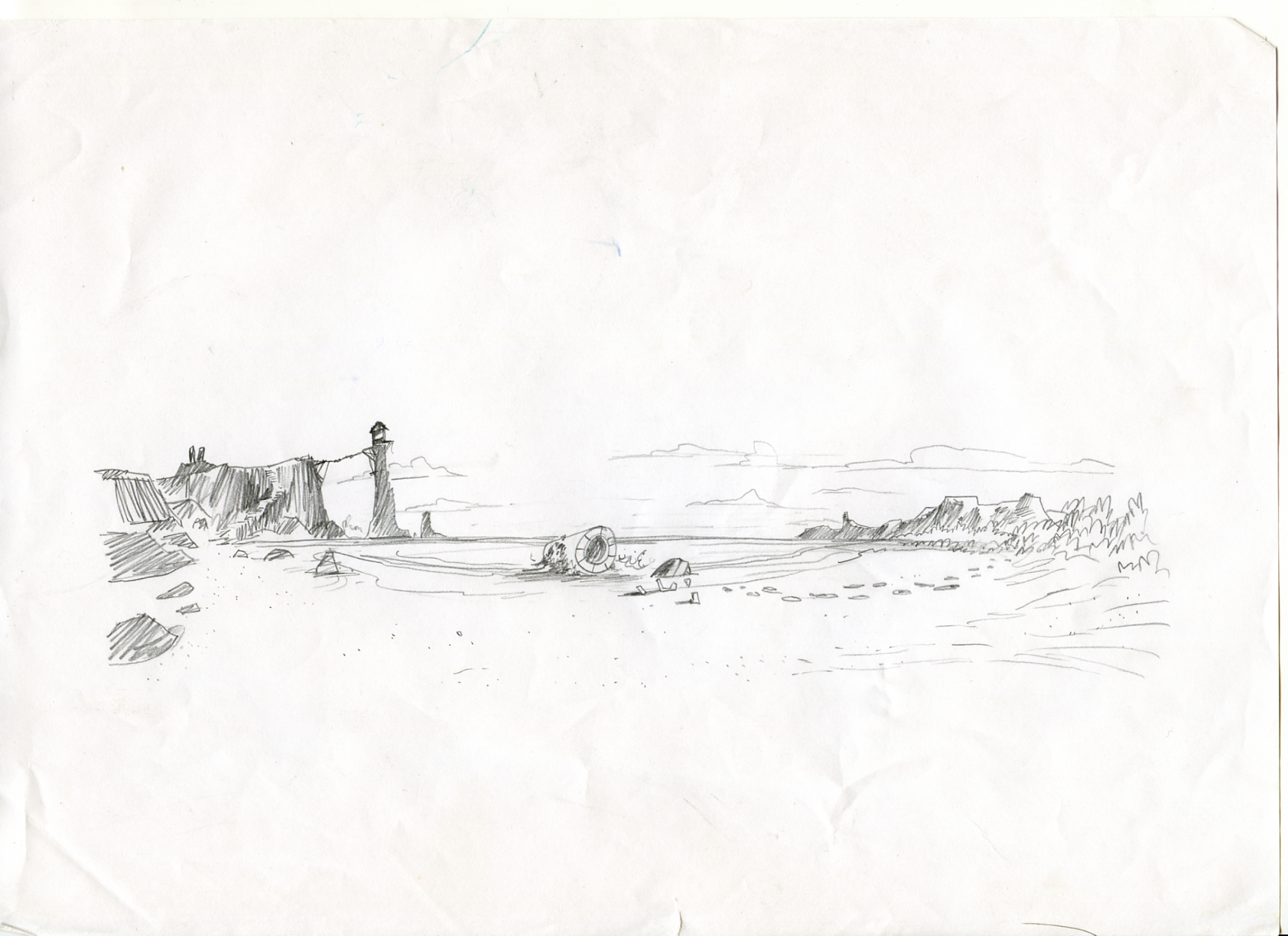 Concept art for MNOG?s first program
Concept art for MNOG?s first program
In our emails, Mack said that the image of the canister on the beach was of particular importance to the game that Mata Nui Online would end up being. Though the image was not of their creation, the weight of the image (which Mack called an ?emotive, non-specific, peaceful image to represent a narrative filled with conflict and adventure?) pushed the team at Templar to make a world that matched that first, enigmatic moment on the island. That image had affected the team at Templar, but even knowing their own feelings about it, none of them could have imagined just how profoundly their game would affect so many other people.
The second of Mata Nui?s programs launched on February 1st, 2001; the third on March 17th; the fourth on May 9th; the fifth on July 11th; and the sixth on August 18th, around the time the first physical sets began hitting store shelves in North America.
And so as August transitioned into September, work began and continued on the seventh of Mata Nui Online?s nine chapters. Now, those of you who have been paying attention to the development timeline here may have already anticipated where the story goes next. On September 11th, 2001, Templar Games ? hours earlier deep in production crafting the snow covered peaks of Mata Nui?s Ko-Wahi and Ko-Koro, and the homes of the then-silent Turaga Nuju and his translator Matoro, the latter of which was set to become a hero of his own storyline years later ? watched from the roof of their offices in Manhattan?s Lower East Side as fire and smoke billowed from the twin towers of the World Trade Center. The events of the September 11th terror attacks pushed the team at Templar further into the world they were creating ? a rare case of videogames becoming a form of escapism not just for those playing them, but also those creating them. Mack said that, ?as the world became bleaker and bleaker? and ?Amid the chaos and fear [of the September 11th attacks], it was somehow comforting that Program 7 took place among the peaceful snows of Ko-Koro and its silent existentialists. The war would come, but not until next month, in the real world as on Mata Nui.?
In the weeks that followed, winds from the south would hold the East Village captive in an odd smelling fog, and Mack recalls several nights spent sleeping in the office as the team at Templar worked to complete Mata Nui Online?s seventh program. Templar?s office manager even brought toothbrushes and toothpaste to the office, as overnight occupation of the office became the norm.
Chapter Seven would launch on October 10th, around the time The Legend of Mata Nui would be formally cancelled by The LEGO Group. Legend?s original release date of September had come and gone, and with the new December release looming, LEGO pulled the plug ? leaving the weight of Bionicle?s narrative advancement (and conclusion) squarely on the shoulders of Templar Games and the still relatively new Bionicle?s comics ? as helmed by writer Greg Farshtey.
Chapter Eight would release on November 17th, and now the endgame was in sight. But as Mata Nui Online was nearing its climatic end and armies of workers were still sifting through the rubble at Ground Zero, Templar found that their perspective on the classic ?good vs. evil? story had dramatically shifted. According to Mack the finals months of Mata Nui Online?s narrative had been planned out since before the September 11th attacks, but in the months following they found that the subtext of the story had shifted. Here?s how Mack tells it:
?At the end, it was time to draw out the main theme that had been with us since the beginning. The story was about a battle ? but between who? Violence, for us, had a different meaning?
Good and evil just wasn?t good enough any more. It didn?t make any sense any more. But this was okay, because from the beginning, that?s not what it was about. The Makuta wasn?t evil, and his brother, Mata Nui, wasn?t good.
We knew that while building was fun, it was just as much fun to destroy. They were two sides of the same coin, and neither were wrong: it was all part of the play, part of learning, part of having fun. Not good or evil: Creation and Destruction, equal powers in the universe, natural and necessary. Both good. Both bad. Both neither. It?s true, we?d painted Destruction a bit negatively ? using words like ?Infected? Mask, or ?Monsters,? but we?d needed the conflict.
So the Makuta, for all its darkness and danger, was not evil after all, and he says as much at the end. The final act was the confrontation, not between Good and Evil, which was meaningless, but between Creation and Destruction, where everything comes from nothing, and goes back to it, eventually. This was the struggle between the Toa and the Rahi, and Mata Nui and Makuta, and a LEGO fan and her kid brother, building and smashing happily, in equal measure. Our world had gone a bit mad, but to us, this helped make some sense of it. We wanted to share what small comfort it brought.?
So Mata Nui Online Game continued to be a game not about what you?d expect. It wasn?t about good and evil, and it didn?t really have heroes. Well, it did in a way, but not the ones you?d expect. The Bionicle comics were doing their job telling the tales of the Toa, so what was left for Templar? Who were the real heroes of their story? Well, in the end, it was the Matoran. Mack found it ironic, that ?both literally and metaphorically, the powerless little [Matoran] ? ended up being the heroes after all? ? both to the island inhabitants of Mata Nui, and, in a way, to The LEGO Group itself.
Mack elaborated on this idea:
??there was no story at all for the Matoran for 2001. They?d [The LEGO Group] mapped everything out for Tahu and Gali and the others before handing it to Greg [Farshtey] ? but not us. While the REAL heroes ? the big ones with the big swords (and the big price points) ? were out saving the world, what were the [Matoran] doing? Just being saved?
What they [The LEGO Group] gave us at the beginning were the helpless, powerless, small. Insignificant, without even a part in the main story, except to be rescued from time to time.
But sometime toward the end, we realized that?s exactly what our audience was: the small, the powerless. Those whose stories are yet to be written. Kids.
And not just kids ? Bionicle kids. So we pushed it further. The Toa were heroes ? Takua [the Player character] was not, and nor were his friends. They were small and powerless, just like the kids playing. And maybe they weren?t even the popular kids. So the band of Matoran you assemble isn?t even the best and brightest. It?s not the Turaga?s right-hands, it?s their lefts: the misfits, the weirdos. A Le-Koran who can?t fly. A Po-Koran no one likes. A Ko-Koran that can?t talk.
When you go to get help, the Turaga don?t give you their GOOD people. What you get are the losers. Maybe there were more than a few Bionicle fans who identified with them. And we wanted to show that in the end, they could be heroes, too.?
Now that is a more beautiful message than any of us deserved from an early 2000s Flash game. This final chapter would launch on December 15th, 2001, and with it, solidify Mata Nui Online Game as the Bionicle story of 2001.
The success of Mata Nui Online amidst the greater story of Bionicle?s early successes allowed Templar to continue their relationship with The LEGO Group through a series of interstitial Bionicle animations for the 2002 Bohrok subplot and a Mata Nui Online sequel, The Final Chronicle, which followed the Matoran Hahli on a more personal adventure across the landscape of the island of Mata Nui ? which unlike Mata Nui Online?s Myst inspirations, would fall more into the realm of games like Ultima IV and Diablo. Templar?s work on the Bionicle series would end with a series of animations for the 2004 storyline, military-propaganda-style videos for Metru Nui?s Vahki enforcers ? though that wouldn?t stop Mack from flying across the Atlantic to pitch LEGO on a Templar-helmed Bionicle PC game, though nothing ended up manifesting from that trip.
So why have I gone on for so long about this Flash game from 2001? Well, there is a timelessness to Mata Nui Online Game that cannot be said for many Flash games of its era, and Mata Nui Online?s legacy cannot be overstated. I mean, I?m here writing about it in 2020, 19 years after it came out. That?s got to count for something, right? I?ve even gone back and replayed it several times since its release, which is not something I can say for literally any other Flash game I?ve ever played in my life time. Mata Nui Online stands in a league of its own.
And for whatever bits of Mata Nui Online?s story LEGO tried to sweep under the rug in the years following its release (things like the Ko-Koran Turaga Nuju no longer being mute in subsequent Bionicle media), for fans like me it was the story of Bionicle?s earliest days. Bionicle was all my friends and I could talk about back then, and we?d constantly quote lines from the game to one another (?Another Hafu original? was a perennial favorite). And Mack thinks it was likely fans love for the game that forced LEGO?s hand in retroactively canonizing many of Mata Nui Online?s story elements.
Now, writing this story over the past few weeks, honestly, has felt like coming home to an old friend. And getting to hear these stories of the game?s development from the developers themselves has been like looking through a family photo album I?d never seen before. Throughout our emails exchanges I couldn?t help but gush to Peter here and there about my love and appreciation for the game they made, and though I don?t know how many emails like mine they?ve received in the years since Mata Nui Online first hit the web, it?s legacy is well known to them now ? though it wasn?t alway that way. In 2001 Templar was just happy that LEGO was happy with the product. Fans seemed to be enjoying it, but the lasting impact was yet to be seen. Mack thinks that part of Mata Nui Online?s longevity is that the game didn?t pander to anyone. While it was a game expected to be played by kids, none of it was ?made for kids?. The LEGO Group had given Templar a lot of freedom in the creation of Mata Nui Online ? likely too much freedom in LEGO?s mind, keeping in mind the aforementioned attempted retcons of Templar?s story elements ? but it was that freedom, like it or not, that let Templar make the best game they could.
Well, if you?ve made it this far it?s probably because you?re a big fan of Bionicle, like me. What?s your favorite memory of the Mata Nui Online Game? Let us know me know! And if you haven?t played Mata Nui Online in a while or have never played it before, head on over to BioMediaProject.com and play it for yourself. I promise you it?s worth it.
